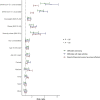Decreased Self-reported Physical Fitness Following SARS-CoV-2 Infection and the Impact of Vaccine Boosters in a Cohort Study
- PMID: 38130596
- PMCID: PMC10733205
- DOI: 10.1093/ofid/ofad579
Decreased Self-reported Physical Fitness Following SARS-CoV-2 Infection and the Impact of Vaccine Boosters in a Cohort Study
Abstract
Background: The long-term effects of coronavirus disease 2019 (COVID-19) on physical fitness are unclear, and the impact of vaccination on that relationship is uncertain.
Methods: We compared survey responses in a 1-year study of US military service members with (n = 1923) and without (n = 1591) a history of severe acute respiratory syndrome coronavirus 2 (SARS-CoV-2) infection. We fit Poisson regression models to estimate the association between history of SARS-CoV-2 infection and fitness impairment, adjusting for time since infection, demographics, and baseline health.
Results: The participants in this analysis were primarily young adults aged 18-39 years (75%), and 71.5% were male. Participants with a history of SARS-CoV-2 infection were more likely to report difficulty exercising (38.7% vs 18.4%; P < .01), difficulty performing daily activities (30.4% vs 12.7%; P < .01), and decreased fitness test (FT) scores (42.7% vs 26.2%; P < .01) than those without a history of infection. SARS-CoV-2-infected participants were at higher risk of these outcomes after adjusting for other factors (unvaccinated: exercising: adjusted risk ratio [aRR], 3.99; 95% CI, 3.36-4.73; activities: aRR, 5.02; 95% CI, 4.09-6.16; FT affected: aRR, 2.55; 95% CI, 2.19-2.98). Among SARS-CoV-2-positive participants, full vaccination before infection was associated with a lower risk of post-COVID-19 fitness impairment (fully vaccinated: exercise: aRR, 0.81; 95% CI, 0.70-0.95; activities: aRR, 0.76; 95% CI, 0.64-0.91; FT: aRR, 0.87; 95% CI, 0.76-1.00; boosted: exercise: aRR, 0.62; 95% CI, 0.51-0.74; activities: aRR, 0.52; 95% CI, 0.41-0.65; FT: aRR, 0.59; 95% CI, 0.49-0.70).
Conclusions: In this study of generally young, healthy military service members, SARS-CoV-2 infection was associated with lower self-reported fitness and exercise capacity; vaccination and boosting were associated with lower risk of self-reported fitness loss.
Keywords: COVID-19; fitness; long COVID.
© The Author(s) 2023. Published by Oxford University Press on behalf of Infectious Diseases Society of America.
Conflict of interest statement
Potential conflicts of interest. 1045 S.D.P., T.H.B., J.S.R., and M.P.S. report that the Uniformed Services University (USU) Infectious Diseases Clinical Research Program (IDCRP), a US Department of Defense institution, and the HJF were funded under a Cooperative Research and Development Agreement to conduct an unrelated phase III COVID-19 monoclonal antibody immunoprophylaxis trial sponsored by AstraZeneca. The HJF, in support of the USU IDCRP, was funded by the Department of Defense Joint Program Executive Office for Chemical, Biological, Radiological, and Nuclear Defense to augment the conduct of an unrelated phase III vaccine trial sponsored by AstraZeneca. Both trials were part of the US Government COVID-19 response. Neither is related to the work presented here. R.C.M. receives research support paid to his institution from Sound Pharmaceuticals for an investigational COVID-19 therapeutic unrelated to the work presented here. M.J.M. is a paid speaker for Xarelto (Janssen Pharmaceuticals). All other authors report no potential conflicts.
Figures


References
-
- Rienks R, Holdsworth D, Davos CH, et al. Cardiopulmonary assessment prior to returning to high-hazard occupations post-symptomatic COVID-19 infection: a position statement of the Aviation and Occupational Cardiology Task Force of the European Association of Preventive Cardiology. Eur J Prev Cardiol 2022; 29:1724–30. - PMC - PubMed
-
- Centers for Disease Control and Prevention . COVID Data Tracker. Available at: https://covid.cdc.gov/covid-data-tracker/#datatracker-home. Accessed December 4, 2022.
Grants and funding
LinkOut - more resources
Full Text Sources
Miscellaneous

